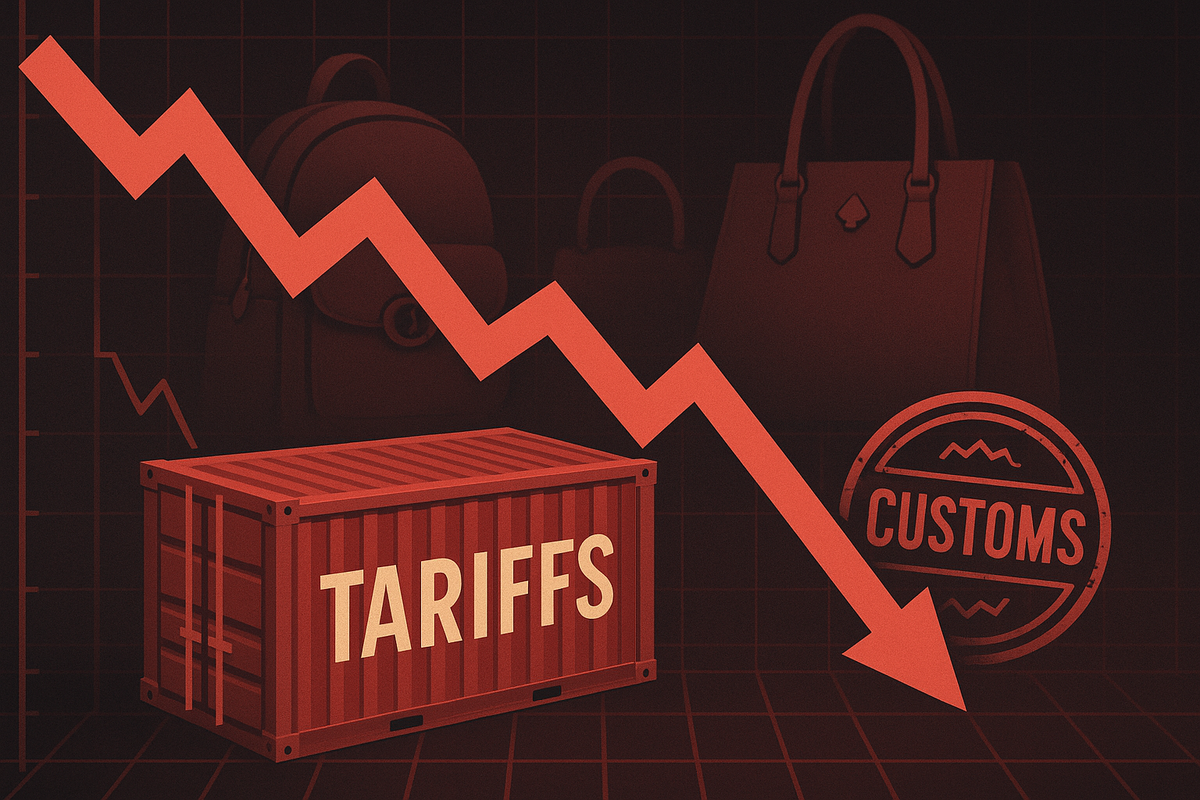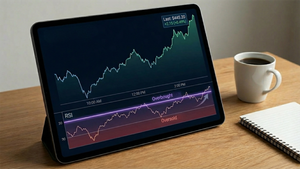
New York, NY – Tapestry Inc. (NYSE: TPR), the parent company of iconic luxury brands Coach, Kate Spade, and Stuart Weitzman, saw its shares plummet by a staggering 16% recently, making it one of the leading decliners on the S&P 500 (NYSEARCA: SPY). This significant drop was triggered by a combination of a disappointing profit outlook for fiscal year 2026 and stark warnings regarding the escalating impact of U.S. import duties. The immediate fallout has sent ripples through the luxury retail sector, raising concerns about consumer demand and the broader economic landscape.
The sharp decline underscores investor sensitivity to forward-looking guidance and macroeconomic headwinds, even as the company reported stronger-than-expected results for the most recent quarter. The market's reaction highlights a growing apprehension about the profitability of global fashion houses grappling with supply chain complexities and evolving trade policies.
Unpacking the Plunge: What Happened and Why It Matters
Tapestry's dramatic stock slide was primarily a reaction to its fiscal year 2026 guidance, which fell short of Wall Street's expectations, rather than its fourth-quarter fiscal year 2025 performance, which actually surpassed analyst estimates for both earnings per share (EPS) and revenue. The company projected fiscal 2026 EPS to be in the range of $5.30 to $5.45, a figure that disappointed analysts who had anticipated closer to $5.48-$5.49 per share, with some even expecting figures exceeding $6.00. This conservative outlook, despite recent strong performance, signaled caution to investors and initiated a swift sell-off.
A major catalyst for this lowered profit forecast is the anticipated financial burden from U.S. import duties. Tapestry's Chief Financial Officer, Scott Roe, explicitly stated that the total expected impact on profitability in fiscal 2026 from tariffs is a substantial $160 million, representing approximately 230 basis points of margin headwind. A critical element of this tariff impact is the earlier-than-expected termination of the "de minimis" exemption. This rule previously allowed low-value shipments (under $800) to enter the U.S. without tariffs, and its ending will significantly increase costs for companies like Tapestry that source goods from countries like Vietnam and the Philippines. The tariffs are expected to disproportionately affect the Kate Spade brand, as the majority of its business is concentrated in the U.S.
Further compounding the concerns, Tapestry recorded a substantial non-cash impairment charge of over $850 million related to its Kate Spade brand. This charge was attributed to current business trends, the outsized impact of tariffs on Kate Spade, and incremental investments aimed at supporting profitable long-term growth for the brand. In response to these pressures, the company also announced plans to streamline Kate Spade's offerings by reducing handbag styles by over 30% by the fall season. The broader luxury market is also facing headwinds, with a general shift in consumer behavior towards more affordable accessories, a trend that has also impacted other major luxury brands like LVMH (EPA: MC) and Kering (EPA: KER).
Navigating the Fallout: Winners and Losers in the Luxury Landscape
The immediate aftermath of Tapestry's announcement has created a clear delineation of potential winners and losers within the luxury and apparel sectors. The most apparent "loser" is Tapestry itself, as evidenced by its significant stock depreciation and the challenges outlined in its forward guidance. The company faces the immediate task of mitigating the $160 million tariff impact, which will undoubtedly pressure its profit margins, particularly for its Kate Spade brand. The impairment charge also signals a need for strategic recalibration within its brand portfolio.
Other companies heavily reliant on global supply chains and susceptible to U.S. import duties are also feeling the pressure. While not directly impacted by Tapestry's specific earnings, the tariff warnings resonate across the industry. Competitors like Capri Holdings (NYSE: CPRI), the parent company of Versace, Michael Kors, and Jimmy Choo, as well as Ralph Lauren (NYSE: RL), PVH Corp. (NYSE: PVH) (owner of Calvin Klein and Tommy Hilfiger), and Abercrombie & Fitch (NYSE: ANF), could face similar cost pressures if trade policies continue to tighten or if their sourcing strategies are not agile enough to adapt. These companies may see increased scrutiny from investors regarding their own supply chain resilience and exposure to tariffs.
Conversely, potential "winners" in this scenario might include companies with more localized supply chains or those less reliant on imports from regions heavily impacted by tariffs. Additionally, brands that cater to a more value-conscious consumer or those with strong domestic manufacturing capabilities could gain a competitive edge. While no direct beneficiaries have emerged from Tapestry's specific woes, the broader market shift towards more affordable accessories could benefit fast-fashion retailers or mid-tier brands that offer stylish alternatives at lower price points. Furthermore, companies that have already diversified their manufacturing bases or invested in advanced supply chain analytics to navigate geopolitical risks may find themselves in a relatively stronger position.
Industry Impact and Broader Implications
Tapestry's recent struggles are not an isolated incident but rather a stark reflection of broader industry trends and macroeconomic pressures impacting the global luxury market. The challenges faced by Tapestry, particularly the significant impact of tariffs and the shift in consumer spending, resonate across the entire luxury retail landscape. This event underscores the increasing vulnerability of global supply chains to geopolitical tensions and trade policy shifts. The termination of the "de minimis" exemption, which previously facilitated tariff-free imports of low-value goods, represents a significant policy change that will undoubtedly affect numerous companies beyond Tapestry that rely on similar sourcing strategies.
The ripple effects of Tapestry's situation could extend to its competitors and partners. Other luxury conglomerates and individual brands that source heavily from countries like Vietnam and the Philippines will likely face similar cost increases, potentially leading to higher retail prices or reduced profit margins across the board. This could trigger a wave of supply chain re-evaluations and diversification efforts as companies seek to mitigate future tariff risks. Furthermore, the broader slowdown in luxury demand, as evidenced by the struggles of even industry giants like LVMH and Kering, suggests a potential softening in consumer discretionary spending, which could impact a wide array of consumer-facing businesses.
Historically, periods of economic uncertainty or trade disputes have often led to shifts in consumer behavior, with a tendency to prioritize value over high-end luxury. This current trend aligns with that historical precedent, suggesting a potential long-term recalibration of the luxury market. Regulatory bodies and policymakers will also be closely watching these developments, as the economic impact of tariffs on major corporations could influence future trade negotiations and policy decisions. The situation at Tapestry serves as a potent reminder of the interconnectedness of global commerce and the profound impact that trade policies can have on corporate profitability and market valuations.
What Comes Next
The immediate future for Tapestry will involve a concerted effort to mitigate the substantial impact of tariffs and to reassure investors of its long-term growth strategy. The company has indicated plans to address the tariff burden through agile manufacturing, optimizing its global supply chain, and selectively implementing price increases. These mitigation efforts are expected to unfold progressively into fiscal years 2027 and 2028, suggesting that the full benefits of these strategies may not be immediately apparent. Investors will be closely watching for tangible progress on these fronts, particularly how effectively Tapestry can shift its sourcing and production to less tariff-exposed regions.
In the short term, Tapestry may face continued volatility in its stock price as the market digests the implications of its revised guidance and the ongoing tariff challenges. The company's strategic pivot for Kate Spade, including the reduction of handbag styles, indicates a focus on streamlining operations and enhancing profitability for the brand. This could lead to a more focused product offering and potentially improved margins for Kate Spade in the long run, but the immediate impact on sales and brand perception will need to be carefully managed.
Looking further ahead, the broader luxury market will likely continue to grapple with evolving consumer preferences and macroeconomic headwinds. Companies that can adapt quickly to changing trade policies, diversify their supply chains, and innovate their product offerings to meet shifting consumer demands will be best positioned for success. This could also present opportunities for smaller, more agile brands to gain market share if larger players struggle to adapt. The ongoing debate around global trade and protectionist policies will remain a critical factor influencing the financial outlook for multinational corporations like Tapestry.
Conclusion
Tapestry's recent 16% stock tumble serves as a potent reminder of the intricate interplay between corporate earnings, global trade policies, and investor sentiment. The key takeaways from this event are clear: even strong quarterly performance can be overshadowed by cautious forward guidance, particularly when significant macroeconomic headwinds like tariffs are at play. The termination of the "de minimis" exemption highlights a growing trend of increased scrutiny on international trade, which will undoubtedly impact companies with extensive global supply chains.
Moving forward, the market will be closely assessing Tapestry's ability to execute its mitigation strategies, particularly its efforts to optimize its supply chain and manage the financial burden of tariffs. Investors should watch for signs of progress in these areas, as well as any further shifts in consumer spending patterns within the luxury sector. The broader implications of this event extend beyond Tapestry, signaling a period of potential recalibration for the entire luxury retail industry as it navigates evolving trade landscapes and consumer preferences. The coming months will be crucial in determining the lasting impact of these challenges on Tapestry and its peers, and how effectively they can adapt to a new era of global commerce.





